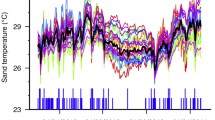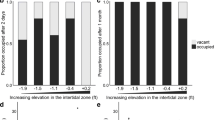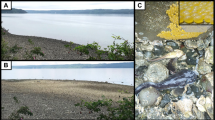Abstract
Revealing the causes and consequences of differential habitat use among previously untrackable species will help advance our understanding of how organisms have survived and adapted during their evolutionary histories. Among loggerhead sea turtles (Caretta caretta) nesting on one Japanese beach, small females tend to forage on planktonic prey in oceanic waters (depth >200 m) as the juveniles do, while large females tend to forage on benthic prey in neritic waters (depth <200 m). These alternative foraging behaviors are presumably maintained by a strategy depending on growth conditions during oceanic early life, and each tactic would be consistently used throughout the adult stage. To verify whether the morphology of emerged hatchlings varies with maternal alternative foraging behaviors, the clutches of similar egg characteristics derived from oceanic and neritic foragers were incubated in a common beach area (30°24′N, 130°26′E), Yakushima Island, Japan, 2014. There were no significant differences in straight carapace length and width and body mass of emerged hatchlings between the two foraging groups, which were classified based on stable isotope ratios, suggesting that the development process of hatchling tissue from yolk and albumen is genetically similar between the two groups. Egg size and mass significantly increased with female body size only in neritic foragers that laid larger clutches than oceanic foragers, whereas hatchling size and mass significantly increased with egg mass in both groups. This suggested that larger females produced larger hatchlings within neritic foragers, and indeed, there was a significant positive correlation in body size between females and hatchlings only within neritic foragers. However, significant negative correlations between the number of eggs reburied per nest and emergence success that might explain the above phenomenon were not found in either oceanic or neritic foragers. Effects of a seasonal rise in ambient temperature on embryonic development and hatchling morphology were also similar between the two foraging groups, implying their genetic similarity in thermal response, consistent with their phenotypic plasticity.





Similar content being viewed by others
References
Ackerman RA (1997) The nest environment and the embryonic development of sea turtles. In: Lutz PL, Musick JA (eds) The biology of sea turtles, vol I. CRC Press, Boca Raton, pp 83–106
Avens L, Goshe LR, Pajuelo M, Bjorndal KA, MacDonald BD, Lemons GE, Bolten AB, Seminoff JA (2013) Complementary skeletochronology and stable isotope analyses offer new insight into juvenile loggerhead sea turtle oceanic stage duration and growth dynamics. Mar Ecol Prog Ser 491:235–251
Bjorndal KA, Carr A (1989) Variation in clutch size and egg size in the green turtle nesting population at Tortuguero, Costa Rica. Herpetologica 45:181–189
Bolnick DI, Svanbäck R, Fordyce JA, Yang LH, Davis JM, Hulsey CD, Forister ML (2003) The ecology of individuals: incidence and implications of individual specialization. Am Nat 161:1–28
Booth DT, Feeney R, Shibata Y (2013) Nest and maternal origin can influence morphology and locomotor performance of hatchling green turtles (Chelonia mydas) incubated in field nests. Mar Biol 160:127–137
Bowen BW, Abreu-Grobois FA, Balazs GH, Kamezaki N, Limpus CJ, Ferl RJ (1995) Trans-Pacific migrations of the loggerhead turtle (Caretta caretta) demonstrated with mitochondrial DNA markers. Proc Natl Acad Sci USA 92:3731–3734
Cardona L, Clusa M, Eder E, Demetropoulos A, Margaritoulis D, Rees AF, Hamza AA, Khalil M, Levy Y, Türkozan O, Marín I, Aguilar A (2014) Distribution patterns and foraging ground productivity determine clutch size in Mediterranean loggerhead turtles. Mar Ecol Prog Ser 497:229–241
Ceriani SA, Roth JD, Sasso CR, McClellan CM, James MC, Haas HL, Smolowitz RJ, Evans DR, Addison DS, Bagley DA, Ehrhart LM, Weishampel JF (2014) Modeling and mapping isotopic patterns in the Northwest Atlantic derived from loggerhead sea turtles. Ecosphere 5(9):122
Cheng I-J, Lin C-H, Tseng C-T (2015) Factors influencing variations of oxygen content in nests of green sea turtles during egg incubation with a comparison of two nesting environments. J Exp Mar Biol Ecol 471:104–111
Christians JK (2002) Avian egg size: variation within species and infexibility within individuals. Biol Rev 77:1–26
da Costa Araújo J, e Rosa PV, das Dores Correia Palha M, Rodrigues PB, de Freitas RTF, do Socorro Lima da Silva A (2013) Effect of three feeding management systems on some reproductive parameters of Scorpion mud turtles (Kinosternon scorpioides) in Brazil. Trop Anim Health Prod 45:729–735
Danzmann RG, Ferguson MM, Skúlason S, Snorrason SS, Noakes DLG (1991) Mitochondrial DNA diversity among four sympatric morphs of Arctic charr, Salvelinus alpinus L., from Thingvallavatn, Iceland. J Fish Biol 39:649–659
Denoël M, Joly P, Whiteman HH (2005) Evolutionary ecology of facultative paedomorphosis in newts and salamanders. Biol Rev 80:663–671
Eder E, Ceballos A, Martins S, Pérez-García H, Marín I, Marco A, Cardona L (2012) Foraging dichotomy in loggerhead sea turtles Caretta caretta off northwestern Africa. Mar Ecol Prog Ser 470:113–122
Gíslason D, Ferguson MM, Skúlason S, Snorasson SS (1999) Rapid and coupled phenotypic and genetic divergence in Icelandic Arctic char (Salvelinus alpinus). Can J Fish Aquat Sci 56:2229–2234
Gross MR (1996) Alternative reproductive strategies and tactics: diversity within sexes. Trends Ecol Evol 11:92–98
Harrison RG (1980) Dispersal polymorphisms in insects. Ann Rev Ecol Syst 11:95–118
Hatase H, Matsuzawa Y, Sakamoto W, Baba N, Miyawaki I (2002a) Pelagic habitat use of an adult Japanese male loggerhead turtle Caretta caretta examined by the Argos satellite system. Fish Sci 68:945–947
Hatase H, Takai N, Matsuzawa Y, Sakamoto W, Omuta K, Goto K, Arai N, Fujiwara T (2002b) Size-related differences in feeding habitat use of adult female loggerhead turtles Caretta caretta around Japan determined by stable isotope analyses and satellite telemetry. Mar Ecol Prog Ser 233:273–281
Hatase H, Matsuzawa Y, Sato K, Bando T, Goto K (2004) Remigration and growth of loggerhead turtles (Caretta caretta) nesting on Senri Beach in Minabe, Japan: life-history polymorphism in a sea turtle population. Mar Biol 144:807–811
Hatase H, Sato K, Yamaguchi M, Takahashi K, Tsukamoto K (2006) Individual variation in feeding habitat use by adult female green sea turtles (Chelonia mydas): are they obligately neritic herbivores? Oecologia 149:52–64
Hatase H, Omuta K, Tsukamoto K (2013) A mechanism that maintains alternative life histories in a loggerhead sea turtle population. Ecology 94:2583–2594
Hatase H, Omuta K, Komatsu T (2014) Do loggerhead turtle (Caretta caretta) eggs vary with alternative foraging tactics? J Exp Mar Biol Ecol 455:56–61
Hawkes LA, Broderick AC, Coyne MS, Godfrey MH, Lopez-Jurado L-F, Lopez-Suarez P, Merino SE, Varo-Cruz N, Godley BJ (2006) Phenotypically linked dichotomy in sea turtle foraging requires multiple conservation approaches. Curr Biol 16:990–995
Hays GC, Speakman JR (1993) Nest placement by loggerhead turtles, Caretta caretta. Anim Behav 45:47–53
Hays GC, Adams CR, Speakman JR (1993) Reproductive investment by green turtles nesting on Ascension Island. Can J Zool 71:1098–1103
Hays GC, Fossette S, Katselidis KA, Mariani P, Schofield G (2010) Ontogenetic development of migration: Lagrangian drift trajectories suggest a new paradigm for sea turtles. J R Soc Interface 7:1319–1327
Iguchi K (2012) Egg size plasticity corresponding to maternal food conditions in an annual fish, Ayu Plecoglossus altivelis. Ichthyol Res 59:14–19
Janzen FJ (1993) An experimental analysis of natural selection on body size of hatchling turtles. Ecology 74:332–341
Jones TT, Seminoff JA (2013) Feeding biology: advances from field-based observations, physiological studies, and molecular techniques. In: Wyneken J, Lohmann KJ, Musick JA (eds) The biology of sea turtles, vol III. CRC Press, Boca Raton, pp 211–247
Jonsson B, Jonsson N (1993) Partial migration: niche shift versus sexual maturation in fishes. Rev Fish Biol Fish 3:348–365
Jonsson N, Jonsson B, Fleming IA (1996) Does early growth cause a phenotypically plastic response in egg production of Atlantic Salmon? Funct Ecol 10:89–96
Kamel SJ, Mrosovsky N (2005) Repeatability of nesting preferences in the hawksbill sea turtle, Eretmochelys imbricata, and their fitness consequences. Anim Behav 70:819–828
Kaplan RH (1987) Developmental plasticity and maternal effects of reproductive characteristics in the frog, Bombina orientalis. Oecologia 71:273–279
Lowther AD, Harcourt RG, Hamer DJ, Goldsworthy SD (2011) Creatures of habit: foraging habitat fidelity of adult female Australian sea lions. Mar Ecol Prog Ser 443:249–263
Lundberg P (1988) The evolution of partial migration in birds. Trends Ecol Evol 3:172–175
Mansfield KL, Wyneken J, Porter WP, Luo J (2014) First satellite tracks of neonate sea turtles redefine the ‘lost years’ oceanic niche. Proc R Soc B 281:20133039
Matsuzawa Y, Sato K, Sakamoto W, Bjorndal KA (2002) Seasonal fluctuations in sand temperature: effects on the incubation period and mortality of loggerhead turtle (Caretta caretta) pre-emergent hatchlings in Minabe, Japan. Mar Biol 140:639–646
McGinley MA (1989) The influence of a positive correlation between clutch size and offspring fitness on the optimal offspring size. Evol Ecol 3:150–156
Morita K, Takashima Y (1998) Effect of female size on fecundity and egg size in white-spotted charr: comparison between sea-run and resident forms. J Fish Biol 53:1140–1142
Özdemir A, Ilgaz Ç, Kumlutaş Y, Durmuş SH, Kaska Y, Türkozan O (2007) An assessment of initial body size in loggerhead sea turtle (Caretta caretta) hatchlings in Turkey. Zool Sci 24:376–380
Pajuelo M, Bjorndal KA, Reich KJ, Arendt MD, Bolten AB (2012) Distribution of foraging habitats of male loggerhead turtles (Caretta caretta) as revealed by stable isotopes and satellite telemetry. Mar Biol 159:1255–1267
Parker GA, Begon M (1986) Optimal egg size and clutch size: effects of environment and maternal phenotype. Am Nat 128:573–592
Pinckney J (1990) Correlation analysis of adult female, egg and hatchling sizes in the loggerhead turtle, Caretta caretta (L.), nesting at Kiawah Island, South Carolina, USA. Bull Mar Sci 47:670–679
Read T, Booth DT, Limpus CJ (2012) Effect of nest temperature on hatchling phenotype of loggerhead turtles (Caretta caretta) from two South Pacific rookeries, Mon Repos and La Roche Percée. Aust J Zool 60:402–411
Reznick D, Yang AP (1993) The influence of fluctuating resources on life history: patterns of allocation and plasticity in female guppies. Ecology 74:2011–2019
Skúlason S, Snorrason SS, Noakes DLG, Ferguson MM (1996) Genetic basis of life history variations among sympatric morphs of Arctic char, Salvelinus alpinus. Can J Fish Aquat Sci 53:1807–1813
Smith CC, Fretwell SD (1974) The optimal balance between size and number of offspring. Am Nat 108:499–506
Tiwari M, Bjorndal KA (2000) Variation in morphology and reproduction in loggerheads, Caretta caretta, nesting in the United States, Brazil, and Greece. Herpetologica 56:343–356
Vander Zanden HB, Bjorndal KA, Reich KJ, Bolten AB (2010) Individual specialists in a generalist population: results from a long-term stable isotope series. Biol Lett 6:711–714
Vander Zanden HB, Pfaller JB, Reich KJ, Pajuelo M, Bolten AB, Williams KL, Frick MG, Shamblin BM, Nairn CJ, Bjorndal KA (2014) Foraging areas differentially affect reproductive output and interpretation of trends in abundance of loggerhead turtles. Mar Biol 161:585–598
Varo-Cruz N, Hawkes LA, Cejudo D, López P, Coyne MS, Godley BJ, López-Jurado LF (2013) Satellite tracking derived insights into migration and foraging strategies of male loggerhead turtles in the eastern Atlantic. J Exp Mar Biol Ecol 443:134–140
Vieira S, Martins S, Hawkes LA, Marco A, Teodósio MA (2014) Biochemical indices and life traits of loggerhead turtles (Caretta caretta) from Cape Verde Islands. PLoS ONE 9:e112181
Volpe JP, Ferguson MM (1996) Molecular genetic examination of the polymorphic Arctic charr Salvelintis alpinus of Thingvallavatn, Iceland. Mol Ecol 5:763–772
Wallace BP, Saba VS (2009) Environmental and anthropogenic impacts on intra-specific variation in leatherback turtles: opportunities for targeted research and conservation. Endanger Species Res 7:11–21
Wallace BP, Sotherland PR, Spotila JR, Reina RD, Franks BF, Paladino FV (2004) Biotic and abiotic factors affect the nest environment of embryonic leatherback turtles, Dermochelys coriacea. Physiol Biochem Zool 77:423–432
Wallace BP, Sotherland PR, Tomillo PS, Reina RD, Spotila JR, Paladino FV (2007) Maternal investment in reproduction and its consequences in leatherback turtles. Oecologia 152:32–47
Warner DA, Lovern MB (2014) The maternal environment affects offspring viability via an indirect effect of yolk investment on offspring size. Physiol Biochem Zool 87:276–287
Warner DA, Lovern MB, Shine R (2007) Maternal nutrition affects reproductive output and sex allocation in a lizard with environmental sex determination. Proc R Soc B 274:883–890
Watanabe KK, Hatase H, Kinoshita M, Omuta K, Bando T, Kamezaki N, Sato K, Matsuzawa Y, Goto K, Nakashima Y, Takeshita H, Aoyama J, Tsukamoto K (2011) Population structure of the loggerhead turtle Caretta caretta, a large marine carnivore that exhibits alternative foraging behaviors. Mar Ecol Prog Ser 424:273–283
Weber SB, Broderick AC, Groothuis TGG, Ellick J, Godley BJ, Blount JD (2012) Fine-scale thermal adaptation in a green turtle nesting population. Proc R Soc B 279:1077–1084
Yakushima Sea Turtle Research Group (2011) Report on the ecology of sea turtles at Yakushima Island during 1985–2009. Yakushima Sea Turtle Research Group, Kagoshima (in Japanese)
Acknowledgments
We thank T. Hidaka, the staff (M. Ono, N. Omuta, T. Araishi, S. Koide, and M. Uchida) and volunteers (R. Shimizu, N. Sugio, R. Kawasaki, K. Nakajima, K. Yamada, and others) of the Yakushima Sea Turtle Research Group for field assistance and logistical support. The Associate Editor, G.C. Hays, and one anonymous reviewer provided constructive criticism. Field sampling was conducted under licenses issued by the municipalities of Kagoshima Prefecture (Nos. 11-2 and 11-3) and Yakushima Town (No. 981) and in accordance with the Animal Care Authorization (No. P14-1) of The University of Tokyo. This work was supported by JSPS KAKENHI Grant Number 25870141 to H.H.
Author information
Authors and Affiliations
Corresponding author
Ethics declarations
Funding
This study was funded by JSPS KAKENHI (Grant Number 25870141) to the first author, Hideo Hatase.
Conflict of interest
The authors declare that they have no conflict of interest.
Ethical standard
All procedures performed in this study involving animals were in accordance with the Animal Care Authorization (No. P14-1) of The University of Tokyo.
Additional information
Communicated by B. Wallace.
Reviewed by G.C. Hays and an undisclosed expert.
Electronic supplementary material
Below is the link to the electronic supplementary material.
Rights and permissions
About this article
Cite this article
Hatase, H., Omuta, K. & Komatsu, T. Loggerhead turtle (Caretta caretta) offspring size does not vary with maternal alternative foraging behaviors: support for their phenotypic plasticity. Mar Biol 162, 1567–1578 (2015). https://doi.org/10.1007/s00227-015-2693-x
Received:
Accepted:
Published:
Issue Date:
DOI: https://doi.org/10.1007/s00227-015-2693-x




